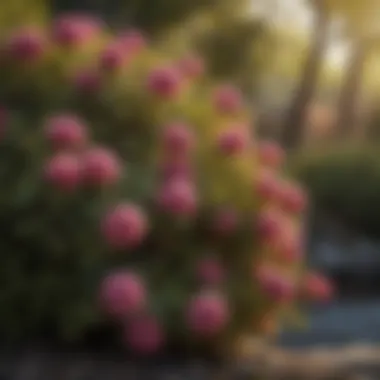Early Spring Flowering Shrubs: A Complete Guide


Intro
Early spring flowering shrubs play a significant role in residential and public gardens. As the cold weather starts to mellow, these shrubs become the first heralds of spring, exhibiting their blossoms bravely in the wake of winter's departure. Not only do they add aesthetic appeal, but they also provide crucial benefits to local ecosystems by supporting diverse wildlife.
In this comprehensive guide, we will explore various facets of early spring flowering shrubs. This includes their significance in landscape design, a selection of species adapted to different climates, and essential care practices. We aim to provide meaningful insights that enhance not just the beauty of gardens but also their ecological contributions.
Design Inspiration
Designing a garden requires careful consideration of plant selection. Early spring flowering shrubs can serve as inspiration for gardeners and landscape designers alike. They can create focal points and vibrant backdrops for other plants.
When incorporating these shrubs, it is essential to think about the current design trends. Many modern styles favor a minimalist approach, emphasizing clean lines and simplicity. Shrubs such as Forsythia and Magnolia lend themselves well to this trend, offering striking visual elements without overwhelming the space.
Color Palettes and Their Effects
The color of blossoms varies extensively among different early spring flowering shrubs, influencing the overall mood of the garden. Bright yellows from Forsythia can create a cheerful atmosphere, while the delicate pinks of Cherry Blossom induce tranquility. Selecting shrubs based on desired color palettes not only enhances visual appeal but can also evoke specific feelings and moods in outdoor spaces.
Choosing a complementary palette can lead to remarkable visual results. Consider the following combinations:
- Bright Yellow and Soft Blue: Combining Forsythia with various blue-toned perennials.
- Deep Pink and White: Pairing Magnolia with white flowering plants like Snowdrop.
- Lavender and Cream: Utilizing Lilac alongside cream-colored blooms for a subtle effect.
"Each shrub has its unique story to tell through its flowers, contributing to the garden's overall narrative."
Gardening enthusiasts can draw from these combinations to inspire their planting schemes, enhancing both aesthetic and emotional depth.
Prelude to Early Spring Flowering Shrubs
Early spring flowering shrubs play a crucial role in transforming gardens as winter gives way to warmer weather. These plants are among the first to bloom, offering colorful displays that herald the arrival of spring. Their early blooms not only signal seasonal change but also provide aesthetic pleasure after the monotony of winter.
Defining Early Spring Flowering Shrubs
Early spring flowering shrubs encompass a variety of species that bloom specifically in the early part of the growing season. This group includes shrubs that begin to flower in late winter or early spring, often before new leaves fully emerge. Notable examples include Forsythia, Daphne, and Lilac. These plants can adapt to various environmental conditions, making them suitable for diverse gardens. Their flowering times often coincide with the awakening of pollinators, creating a harmonious relationship between flora and fauna.
The Importance of Early Bloomers
The significance of early spring flowering shrubs extends beyond aesthetics. First, they provide essential nectar and pollen for bees and other pollinators emerging from winter dormancy. Early bloomers can also contribute to the overall health of a garden by providing habitat and food sources for wildlife.
Furthermore, these shrubs fill a gap in the seasonal cycle of flowering plants. As they transition from dormancy to a vibrant display, they bridge the period between late winter and the summer bloomers. This extension of bloom time enriches the visual appeal and biological activity of the garden. Recognizing their value helps gardeners to choose the appropriate species that can enhance their landscape while supporting ecological diversity.
"Incorporating early spring flowering shrubs is a strategic choice for any garden aiming for year-round interest."
Understanding the roles and definitions of these shrubs is foundational for anyone involved in gardening or landscape design. They not only beautify the environment but also foster ecological balance.
Botanical Characteristics
Understanding the botanical characteristics of early spring flowering shrubs is essential for gardeners and landscaping enthusiasts. These features directly influence how these plants thrive in various environments, contribute to the garden's aesthetics, and affect other biological dynamics in the landscape.
Morphological Features
Morphological features refer to the structural attributes of the plants, including size, shape, and arrangement of leaves, flowers, and stems. Early spring flowering shrubs typically display a variety of forms, from compact to sprawling, influencing their placement in gardens. For instance, shrubs like Forsythia, known for their vibrant yellow flowers, can grow up to 10 feet tall, providing an upright focal point in spring landscaping. On the other hand, species like Daphne may reach only three feet high, making them suitable for smaller spaces or as borders.
Leaf structure also plays a critical role in the shrubs' overall health and adaptability. Broad, deciduous leaves absorb sunlight efficiently, while evergreen species have needle-like leaves that reduce water loss. Understanding these variations can aid in selecting the appropriate shrubs based on the specific climatic conditions of your region.
In addition to leaves, flower arrangement is significant. Some shrubs produce flowers in clusters, while others feature solitary blooms. This diversity not only enhances visual appeal but also influences pollinator activity, which is crucial for maintaining garden ecosystems.
Growth Habits and Forms


Growth habits refer to how these shrubs develop over time. There are several growth forms that one might commonly observe, ranging from upright and bushy to low and spreading. For example, the Flowering Quince grows as a dense shrub which can provide hedging while serving as an eye-catching border due to its early blooms.
The growth rate of these shrubs can also vary. Some like Lilac grow relatively quickly and can fill spaces in the garden sooner, while others may take longer to establish but might offer more vibrant or numerous blooms once they mature.
To optimize their growth, crowning attributes, such as pruning practices, need careful consideration. Periodic pruning can encourage bushier growth and abundant flowers, ensuring that each shrub fulfills its role effectively in a landscape.
By understanding these characteristics, gardeners can make informed choices about which shrubs to incorporate into their gardening projects. This knowledge not only helps in selecting species but also in managing the plants to achieve optimal beauty and health throughout the growing season.
Climate Considerations
Understanding climate considerations is paramount for cultivating early spring flowering shrubs. These plants serve not only as beautiful landscape elements but also as essential participants in local ecosystems. The suitability of a shrub species within a specific climate affects its growth, flowering patterns, and overall health. By recognizing factors like temperature, precipitation, and sunlight, gardeners can make informed decisions that yield vibrant, thriving plants.
Understanding Hardiness Zones
Hardiness zones are vital in guiding the selection of plants for any garden. They categorize regions based on temperature extremes, helping homeowners discern which shrubs will thrive in their climate. The United States Department of Agriculture (USDA) defines these zones, ranging from zone 1 (the coldest) to zone 13 (the warmest). Each zone represents the minimum winter temperatures typical for that area, influencing the types of plants that can survive.
For example, Forsythia, commonly found in warmer zones, may struggle in region one due to its sensitivity to extreme cold. Conversely, Lilacs are well-suited to cooler zones while offering fragrant blooms. Therefore, understanding one’s hardiness zone directly impacts the shrub selection process.
"Choosing the right plants for your region is one of the most impactful strategies in landscape design."
Choosing the Right Species for Your Region
Selecting the right species is essential for success in planting early spring flowering shrubs. Homeowners must examine climate patterns, rainfall amounts, and soil types unique to their locale. Each species has specific requirements, and failure to match these can lead to poor performance and even plant failure.
- Forsythia grows best in zones 5-9, requiring full sun and well-drained soil.
- Daphne prefers partial shade with rich, well-draining soil, making it favorable for regions that experience wet springs.
- Lilac, adaptable yet fond of good drainage, thrives in zones 3-7, responding well to plenty of sunlight.
- Flowering Quince shows versatility, adapting to a range of soils and thriving in zones 4-9.
By considering these factors, gardeners will enhance their landscape's beauty while promoting plant health. This thoughtful approach fosters sustainability and contributes positively to local biodiversity.
Popular Early Spring Flowering Shrubs
Exploring popular early spring flowering shrubs is essential for gardeners looking to enhance the seasonal beauty of their landscapes. These shrubs not only provide vibrant colors and textures as winter retreats but also play a critical role in supporting early pollinators. Understanding the characteristics and care needs of specific shrubs empowers homeowners and gardening enthusiasts to make informed choices, maximizing the appeal of their outdoor spaces.
Forsythia
Forsythia is often the first sign of spring, known for its bright yellow flowers that burst forth before the leaves appear. This deciduous shrub grows quickly, making it a popular choice for those seeking rapid results in their gardens. It typically reaches a height of 3 to 10 feet, depending on the species and care conditions.
Care for Forsythia is straightforward. It thrives in full sun to partial shade and adapts well to various soil types, provided it is well-draining. Regular pruning after flowering can help maintain its shape and stimulate new growth. The key benefit of Forsythia is its ability to serve as a vibrant focal point early in the season, offering a cheerful welcome.
Daphne
Daphne species are prized for their fragrant blooms and versatility in garden settings. The small, tubular flowers appear in various colors such as pink, white, and purple, providing not only beauty but also a delightful scent during early spring. These shrubs generally grow to about 2 to 4 feet in height and prefer well-drained soils.
One important consideration for Daphne is their sensitivity to environmental conditions. They require some protection from harsh sunlight and harsh winds, so placing them in slightly sheltered areas is recommended. Despite their care needs, Daphne's allure as a low-maintenance shrub with stunning flowers makes it a favorite among gardeners looking for both fragrance and beauty.
Lilac
Lilac is a classic favorite, celebrated for its captivating clusters of flowers that range from deep purple to soft lavender. Known scientifically as Syringa, lilacs can grow anywhere from 3 to 15 feet tall, depending on the variety. Their robust nature allows them to flourish in various climates, making them suitable for many regions.
Proper sunlight and moderate watering are crucial for lilacs. They thrive in full sun and well-drained soil. The delightful scent that lilacs emit in spring can deeply enhance the overall garden experience. Another benefit is their ability to attract butterflies and hummingbirds, contributing positively to the local ecosystem.
Flowering Quince
Flowering Quince, or Chaenomeles, is an intriguing addition to early blooming shrubs. With vibrant early blooms in shades of red, pink, and white, they stand out in any garden. This hardy shrub typically grows between 3 and 10 feet in height and often features thorny branches.
Aside from its ornamental beauty, Flowering Quince provides not just aesthetic value. It can act as a protective barrier due to its thorns, making it useful in creating more secure garden boundaries. The plant is quite adaptable but prefers well-drained soil and can tolerate various light conditions. Its fruit, while not commonly consumed raw, can be used in jellies and preserves, adding another layer of benefit to this resilient shrub.
In summary: Choosing popular early spring flowering shrubs like Forsythia, Daphne, Lilac, and Flowering Quince not only enhances aesthetic appeal but also supports local wildlife and biodiversity.


Designing with Early Spring Flowering Shrubs
Designing with early spring flowering shrubs brings unique possibilities to landscaping. These shrubs are not just beautiful; they play an important role in the overall aesthetic and biodiversity of gardens. Understanding how to properly integrate these plants can transform an outdoor space into a vibrant display of color and life as winter yields to spring.
Creating Seasonal Interest
Early spring flowering shrubs can establish a seasonal rhythm in landscaping that captivates the eye. As plants like Forsythia and Daphne begin to bloom, they herald the end of winter's starkness. This early burst of color can create visual excitement and anticipation for the warmer months ahead.
Incorporating these shrubs at strategic locations enhances low, mid, and upper layers of a garden. Positioning taller varieties at the back of borders ensures they don’t obscure shorter plants. Layering different species provides depth and texture. A combination of flowering shrubs can result in a continuous display over several weeks. For instance, while one shrub may bloom in March, another may thrive in April, thus extending the visual amazement.
Additionally, it’s vital to consider foliage in early spring. Many shrubs have evergreen leaves that provide structure and color even before flowers emerge. This combination enriches the overall texture of the landscape.
Complementing Other Garden Elements
When designing with early spring flowering shrubs, it is essential to think about how they complement other garden elements. These shrubs can enhance pathways, water features, and even hardscapes. By selecting colors and shapes that harmonize with existing features, the landscape becomes more cohesive.
For instance, pairing Lilacs with paving stones creates a charming entrance that welcomes visitors. Flowering Quince can provide an organic edge to a manicured lawn. Furthermore, consider the overall theme of the garden when incorporating these shrubs. A modern landscape might benefit from the clean lines of a structured hedge, while a cottage garden can be enhanced with more abundant and varied shrubs, creating a relaxed atmosphere.
Cultivation and Maintenance Practices
Cultivating and maintaining early spring flowering shrubs is essential for ensuring their health and vibrancy. Proper care not only enhances their growth cycle but also contributes significantly to their bloom quality. This section will explore crucial elements including soil requirements, watering and fertilization techniques, and pruning methods that are instrumental in sustaining these plants. Understanding these aspects will empower homeowners and gardening enthusiasts to create flourishing gardens that bloom beautifully each spring.
Soil Requirements
The foundation of any thriving shrub begins with the right soil. Early spring flowering shrubs often prefer well-draining soil rich in organic matter. Ideal pH levels for most shrubs range between 6.0 and 7.0, which promotes healthy root systems.
When preparing the soil, consider these points:
- Drainage: Good drainage is crucial to prevent diseases associated with waterlogged roots.
- Organic Matter: Incorporating compost or well-rotted manure can greatly enhance soil fertility and structure, allowing for better moisture retention and nutrient availability.
- Mulching: Adding a layer of mulch helps regulate soil temperature and suppress weeds, contributing to a healthier growing environment.
By paying attention to soil quality, homeowners can create an optimal environment for early spring flowering shrubs to thrive.
Watering and Fertilization Techniques
Watering and fertilizing are hand-in-hand practices that drive the growth of early spring flowering shrubs. Each shrub species may have specific needs; however, some general guidelines apply.
- Watering: These shrubs typically need regular watering during their growing season. It's vital to keep the soil moist but not saturated. An effective method is to water deeply and less frequently, encouraging root growth.
- Fertilization: Early spring is the best time to fertilize, as shrubs begin their growth cycle. A balanced, slow-release fertilizer can provide essential nutrients. Follow the instructions on the package for the best results. Over-fertilization can lead to weak growth and fewer blooms.
Regular watering and appropriate fertilization create conditions for rich foliage and robust flowering, ensuring these shrubs stake their claim as the first champions of spring.
Pruning and Training Methods
Pruning and training early spring flowering shrubs is a critical maintenance practice that impacts their overall shape and blooming potential. Proper techniques can enhance air circulation and light penetration, which are vital for healthy growth.
- Timing: It is generally recommended to prune these shrubs after they bloom in spring. This practice ensures that you do not remove next year's flower buds, providing a balance between aesthetics and functionality.
- Techniques: Common approaches include:
- Selective Pruning: Focus on removing dead or diseased branches to improve plant health.
- Shaping: Training branches can be beneficial for creating a desired shape. Using soft ties gently encourages branches to grow in the direction you want.
- Reduction Pruning: For larger shrubs, reducing the size by cutting back more significant branches can rejuvenate growth and improve flowering.
Engaging in proper pruning techniques ensures that early spring flowering shrubs maintain an attractive and healthy form, promoting a beautiful garden environment.
Regular care and attention to these practices can significantly enhance the beauty and vitality of your early spring flowering shrubs. By focusing on the specific needs of each plant, you can create a garden that celebrates the arrival of spring.
Pests and Diseases
Pests and diseases pose significant challenges for early spring flowering shrubs. Understanding these threats is crucial for maintaining plant health and ensuring vibrant blooms. Addressing these issues early can protect your investment in your garden and enhance the aesthetic quality through each growing season.


Common Pests Affecting Flowering Shrubs
Several pests frequently target flowering shrubs in spring. One of the most common pests is the aphid. These small insects feed on the sap of young shoots and leaves, potentially stunting growth and spreading viruses.
Another pest to watch is the spider mite. They tend to thrive in dry conditions and can create fine webbing on the foliage. Over time, this can lead to yellowing leaves and diminished vigor. Additionally, whiteflies are a nuisance, often clustering on the undersides of leaves. They can cause similar damage to aphids.
Other notable pests include:
- Scale insects: These attach to stems and leaves, sucking sap and weakening plants.
- Japanese beetles: Their voracious appetite can decimate foliage, negatively impacting blooms.
- Caterpillars: Many species can cause significant harm, from defoliation to damaging flower buds.
Identifying these pests early enables effective intervention and prevents larger infestations.
Preventative Disease Management
Managing diseases in flowering shrubs is often a matter of prevention. One important strategy is to ensure proper planting techniques. Adequate spacing allows for proper air circulation, which can reduce the likelihood of fungal infections like powdery mildew.
Regular monitoring is also essential. Inspecting plants frequently can enable you to catch problems before they escalate. If you notice any discolored leaves or signs of distress, act promptly. Removing affected plant parts can limit disease spread.
Another effective measure is the application of fungicides and insecticides. Organic options, such as neem oil, provide a less toxic way to tackle problems without harming beneficial insects. Integrating these practices into your gardening routine can significantly reduce the incidence of pests and diseases.
"Prevention is key when it comes to managing pests and diseases in early spring flowering shrubs. Regular observation, appropriate care, and timely intervention are essential components of a successful strategy."
Building a healthy garden ecosystem encourages resilience against pests and diseases. Making informed choices can facilitate a robust growth environment for your early spring flowering shrubs.
Ecological Importance
Understanding the ecological importance of early spring flowering shrubs contributes significantly to our appreciation of these plants beyond their ornamental value. These shrubs perform crucial roles in the ecosystem, acting as biological links that facilitate interactions between animals and plants. The benefits they provide not only enhance gardens but also support broader environmental health.
Supporting Pollinator Species
Early spring flowering shrubs serve as vital resources for pollinator species, which are essential for maintaining biodiversity. The blossoms of these shrubs produce nectar and pollen that attract bees, butterflies, and other insects during a critical time of year when food sources are scarce. For instance, species such as Forsythia and Daphne bloom very early, often preceding many other plants. This timing is beneficial for local pollinators emerging from winter dormancy, helping them to thrive when they have limited options.
Furthermore, promoting habitats that support pollinator populations can lead to increased pollination of many flowering plants in the vicinity, including vegetables and fruit, thereby enhancing agricultural productivity. It is worth noting that a decline in pollinator populations can negatively affect entire ecosystems. This underscores the importance of incorporating early spring flowering shrubs into both residential and public landscapes.
Contribution to Biodiversity
Early spring flowering shrubs significantly bolster local biodiversity. Their flowers provide essential resources for various wildlife, serving as crucial habitat components in urban and rural settings alike. These plants attract not only pollinators but also birds and small mammals, creating a balanced ecosystem that supports various species.
Additionally, they contribute to genetic diversity within plant communities, which enhances resilience against diseases and climatic changes. This diversity can help sustain local populations of various organisms, facilitating ecological functions such as seed dispersal and nutrient cycling. By cultivating a diverse range of early flowering shrubs, gardeners can play an active role in promoting overall ecosystem health and stability.
"Biodiversity is not just a measure of how many species exist; it’s a reflection of our ability to maintain the delicate balances of life that support us all."
The End
In the ever-evolving field of landscaping, early spring flowering shrubs play a pivotal role. Not only do they herald the new season with their vibrant blooms, but they also generate interest and excitement in gardens that have lain dormant through winter. Understanding the place these shrubs hold in residential and public spaces is crucial for creating aesthetically pleasing environments.
Recap of Benefits and Importance
Early spring flowering shrubs offer numerous advantages. They provide early color and texture to landscapes, bridging the gap between winter's starkness and summer's fullness. These shrubs can attract various pollinators, contributing to the health of the ecosystem. Additionally, many species are well-suited to varying hardiness zones, making them accessible to a wide range of gardeners.
Key Benefits Include:
- Aesthetic Appeal: Their blooms bring beauty to gardens.
- Ecosystem Support: They attract bees, butterflies, and other beneficial insects.
- Versatility: Many species thrive in diverse soil conditions and climates.
Encouraging Early Spring Landscaping
Integrating early spring flowering shrubs into one's landscape can transform an outdoor space. Homeowners are urged to consider including these shrubs in their designs as a method of enhancing seasonal interest. By planning and planting shrubs that bloom early, gardens can maintain visual interest year-round.
To begin, evaluate the local climate and specific space conditions. Selecting the proper species that harmonize with the environment will yield great results. Collaborating with local gardening centers can be beneficial in choosing shrubs that will suit an individual's needs.
Consider these factors when designing your landscape:
- Plant Spacing: Ensure adequate space for growth and air circulation.
- Layering: Combine early bloomers with medium and late bloomers for continuous interest.
- Soil Preparation: Amend soil as necessary to provide the best growth conditions.















